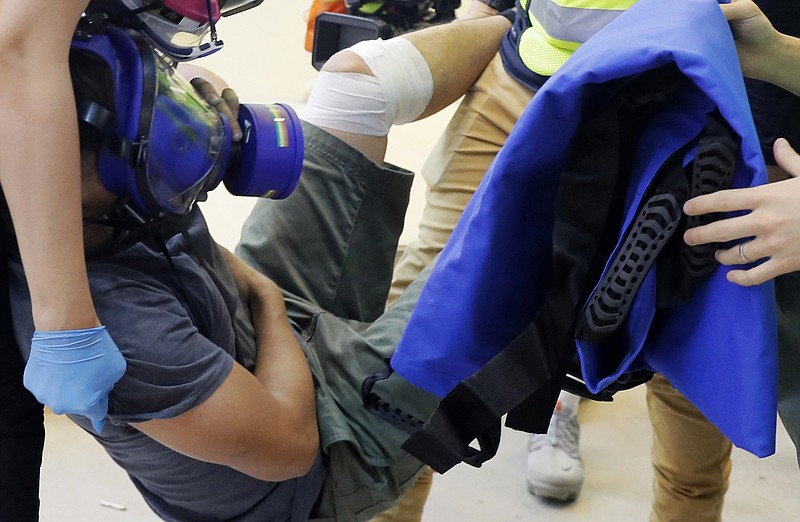HONG KONG (AP) — As riot police fought anti-government demonstrators on the streets of Hong Kong over the weekend, two photos popped into the encrypted inbox of a group of volunteer medics who call themselves the “Hidden Clinic.”
The images showed the nastily swollen left arm of a 22-year-old protester who had been beaten and were accompanied by a message from the sender that said, “I suspect his bone is broken.”
After exchanges through the night via the Telegram messaging app that arranged an off-the-books X-ray, the protester was diagnosed with a displaced fracture of the ulnar bone.
With Hong Kong’s summer of protests now stretching into the fall and clashes becoming increasingly ferocious, medical professionals have quietly banded together to form the Hidden Clinic and other networks to secretly treat the injuries of many young demonstrators who fear arrest if they go to government hospitals.
The person who messaged the network on the injured protester’s behalf later explained the youth’s wariness by saying, “Many of his friends have been detained when seeing doctors.”
The Hidden Clinic says it has clandestinely treated 300-400 protesters with an array of injuries: broken and dislocated bones, gaping wounds and exposure to tear gas so prolonged that they were coughing up blood. It also says the severity of the injuries has increased sharply in the past week, with hard-core protesters and police increasingly tough on each other.
A practitioner who specializes in traditional Chinese medicine and is not affiliated with Hidden Clinic said she alone has treated 60-80 patients, some with multiple wounds from tear-gas canisters and other riot-control projectiles. The woman, who spoke on condition of anonymity because she fears reprisal during her frequent trips to the mainland, uses acupuncture to ease their pain and doesn’t charge for her services.
This behind-the-scenes doctoring, outside of government hospitals, suggests the official toll of 1,235 injured protesters treated in public hospitals since June 9 significantly undercounts the number and full extent of those hurt in the more than 400 demonstrations tallied by the government.
Hong Kong’s chief executive, Carrie Lam, says the casualty count includes injuries to more than 300 police officers. The government tally, compiled by the Hospital Authority, only counts patients who visited 18 public Accident and Emergency departments in the territory of 7.5 million people, not those treated privately.
The protests were triggered in June by a now-abandoned measure that would have allowed criminal suspects to be extradited for trial in Communist Party-controlled courts in mainland China. They’ve flared into sustained fury against Lam’s government, testing commitments from Communist leaders in Beijing not to interfere in the internal affairs of Hong Kong, a semi-autonomous hub for international trade and finance that reverted to Chinese rule in 1997.
The full scope of the clandestine efforts to treat protesters isn’t clear, because the injured and the medics want to protect themselves in the atmosphere of deep distrust that has put Hong Kong on edge. However, interviews by the Associated Press with four practitioners and with protesters treated outside the government health system show it is extensive, underscoring the support the demonstrators enjoy.
One trainee doctor, who wouldn’t give her full name and asked to be identified only as Wong for fear she would damage her career, said her supervisor at a major public hospital doesn’t know of her involvement with Hidden Clinic.
After her regular shifts, she spends her nights dealing with a steady stream of injured protesters, giving them quick, initial diagnoses via text message and photo, and dispensing advice. She then reaches out to the network’s behind-the-scenes doctors, arranging more extensive consultations and treatment — and even help with any costs.
When the protests began, Wong said she used her medical skills on the front lines. She helped assemble Hidden Clinic at the end of July because “I realized the injuries are getting more severe,” she said.
Its name reflects its low profile — its Telegram logo is a bear wearing an identity-concealing surgical mask — but also the many unreported injuries its volunteers see.
“Data published by the government aren’t really accurate anymore, and there are a lot of hidden injuries,” Wong said.
With many distrustful of Lam’s government, and by extension its hospitals, “patients would rather endure the pain and not get arrested,” she said.
For some injuries, Hidden Clinic dispenses temporary treatment that allows protesters to wait a few days before going to an Accident & Emergency facility, so they can lie more convincingly that they weren’t recently hurt in violence.
“You can just say that, oh, you got injured while playing football or something,” Wong said.

